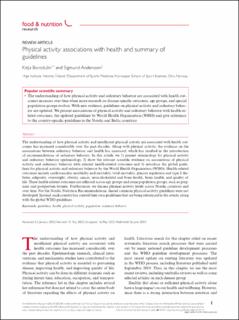| dc.contributor.author | Borodulin, Katja | |
| dc.contributor.author | Anderssen, Sigmund Alfred | |
| dc.date.accessioned | 2024-03-18T07:23:37Z | |
| dc.date.available | 2024-03-18T07:23:37Z | |
| dc.date.created | 2023-09-13T09:41:03Z | |
| dc.date.issued | 2023 | |
| dc.identifier.citation | Food & Nutrition Research. 2023, 67(2023), Artikkel 9719. | en_US |
| dc.identifier.issn | 1654-6628 | |
| dc.identifier.uri | https://hdl.handle.net/11250/3122765 | |
| dc.description | This is an Open Access article distributed under the terms of the Creative Commons Attribution 4.0 International License (http://creativecommons.org/licenses/by/4.0/), allowing third parties to copy and redistribute the material in any medium or format and to remix, transform, and build upon the material for any purpose, even commercially, provided the original work is properly cited and states its license. | en_US |
| dc.description.abstract | The understanding of how physical activity and insufficient physical activity are associated with health outcomes has increased considerably over the past decades. Along with physical activity, the evidence on the associations between sedentary behavior and health has increased, which has resulted in the introduction of recommendations of sedentary behavior. In this article, we 1) present terminology for physical activity and sedentary behavior epidemiology, 2) show the relevant scientific evidence on associations of physical activity and sedentary behavior with selected health-related outcomes and 3) introduce the global guidelines for physical activity and sedentary behavior by the World Health Organization (WHO). Health-related outcomes include cardiovascular morbidity and mortality, total mortality, glucose regulation and type 2 diabetes, adiposity, overweight, obesity, cancer, musculoskeletal and bone health, brain health, and quality of life. These health-related outcomes are reflected across age groups and some population groups, such as pregnant and postpartum women. Furthermore, we discuss physical activity levels across Nordic countries and over time. For the Nordic Nutrition Recommendations, shared common physical activity guidelines were not developed. Instead, each country has created their own guidelines that are being referenced in the article, along with the global WHO guidelines. | en_US |
| dc.language.iso | eng | en_US |
| dc.subject | guidelines | en_US |
| dc.subject | health | en_US |
| dc.subject | physical activity | en_US |
| dc.subject | population | en_US |
| dc.subject | sedentary behavior | en_US |
| dc.title | Physical activity: Associations with health and summary of guidelines | en_US |
| dc.type | Peer reviewed | en_US |
| dc.type | Journal article | en_US |
| dc.description.version | publishedVersion | en_US |
| dc.rights.holder | © 2023 Borodulin and Anderssen | en_US |
| dc.source.pagenumber | 15 | en_US |
| dc.source.volume | 67 | en_US |
| dc.source.journal | Food & Nutrition Research | en_US |
| dc.identifier.doi | 10.29219/fnr.v67.9719 | |
| dc.identifier.cristin | 2174556 | |
| dc.description.localcode | Institutt for idrettsmedisinske fag / Department of Sports Medicine | en_US |
| dc.source.articlenumber | 9719 | en_US |
| cristin.ispublished | true | |
| cristin.fulltext | original | |
| cristin.qualitycode | 1 | |
